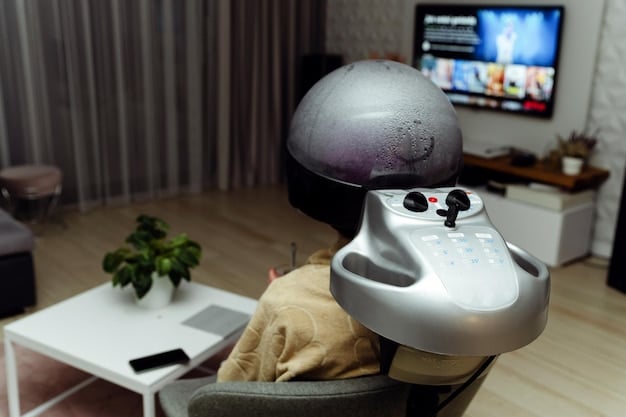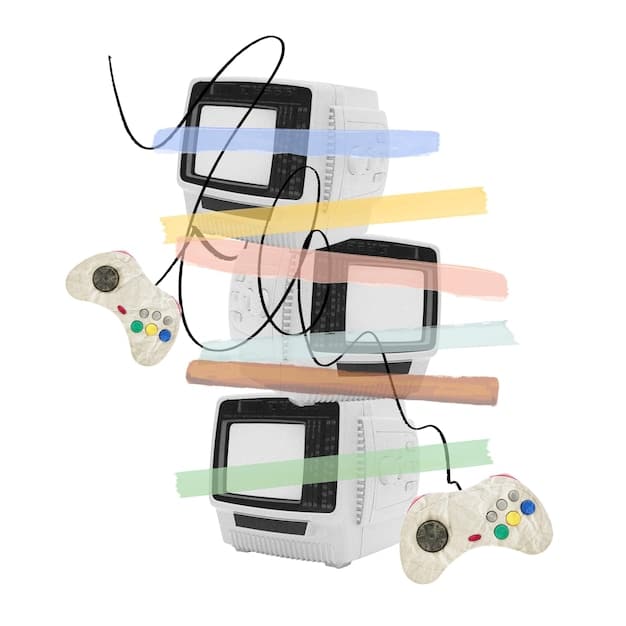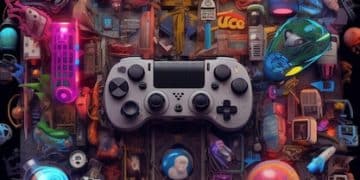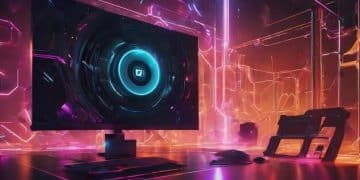Backwards Compatibility: Playing Classic Games on Modern Consoles

Backwards compatibility on consoles allows gamers to enjoy classic titles from older gaming systems on newer hardware, preserving gaming history and offering a diverse range of gaming experiences.
The ability to play games from previous console generations on current systems, also known as backwards compatibility on consoles, has become a significant feature for gamers.
Understanding Backwards Compatibility
Backwards compatibility refers to the ability of a new console to play games designed for older consoles. This feature has been a topic of discussion and demand in the gaming community for years.
It allows gamers to revisit their favorite titles from past generations without needing to keep multiple consoles. This not only saves space but also preserves gaming history.
The Evolution of Backwards Compatibility
The concept of backwards compatibility has evolved over time. Early consoles often lacked this feature due to hardware limitations. However, as technology advanced, it became more feasible.
Some consoles offered limited backwards compatibility, while others provided extensive support. Today, it’s a feature that many gamers expect from new consoles.
- Preservation of classic games for future generations.
- Convenience of playing older titles on modern hardware.
- Cost savings by avoiding the need to purchase multiple consoles.
Backwards compatibility ensures that classic games are not forgotten and can be enjoyed by new audiences. It also fosters a sense of nostalgia for older gamers.
The History of Backwards Compatibility in Gaming
Backwards compatibility has a rich history in the gaming industry. Different consoles have approached this feature in various ways, each with its own advantages and limitations.
Understanding the history of backwards compatibility provides insight into the challenges and successes of implementing this feature.

Early Attempts at Backwards Compatibility
The Atari 7800 was one of the earliest consoles to offer backwards compatibility, allowing it to play Atari 2600 games. This was a significant selling point at the time.
Later, the Nintendo Game Boy Advance could play Game Boy and Game Boy Color games, providing a vast library of playable titles.
Backwards compatibility was not always a given, and many consoles from the 8-bit and 16-bit eras did not support older games. This was largely due to hardware constraints and different cartridge formats.
Backwards Compatibility in the 2000s
The PlayStation 2 was a major success, partly due to its ability to play original PlayStation games. This feature was highly appreciated by gamers.
The Nintendo GameCube, however, did not offer backwards compatibility with Game Boy Advance games, which disappointed some fans.
- PlayStation 2’s successful implementation of PS1 backwards compatibility.
- Nintendo’s varying approaches to backwards compatibility across different consoles.
- The impact of hardware limitations on the feasibility of backwards compatibility.
The implementation of backwards compatibility in the 2000s set a precedent for future consoles. It showed that gamers valued the ability to play older games on newer hardware.
How Backwards Compatibility Works
The technical aspects of backwards compatibility can be complex. Different methods are used to enable newer consoles to play older games.
Understanding these methods can help gamers appreciate the work that goes into making backwards compatibility possible.
Hardware Emulation
Hardware emulation involves recreating the hardware of an older console within the new console. This allows the new console to run older games natively.
This method is often used when the hardware architectures of the old and new consoles are significantly different.
Software Emulation
Software emulation uses software to mimic the functions of the older console’s hardware. This method is more common and flexible.
- Hardware emulation provides native performance but is more complex.
- Software emulation is more flexible but may introduce performance issues.
- Hybrid approaches combine hardware and software emulation for optimal results.
Emulation, whether through hardware or software means that games can be run, even if they were not originally designed for the console. This method offers solutions to get around constraints and to play the games.
Software emulation is often used for digital versions of games, where the game files are adapted to run on the newer console’s operating system.
Benefits of Backwards Compatibility
Backwards compatibility offers numerous benefits to gamers and the gaming industry. These benefits contribute to a more enjoyable and accessible gaming experience.
From preserving gaming history to providing cost savings, the advantages of backwards compatibility are significant.

Preserving Gaming History
Backwards compatibility helps preserve gaming history by ensuring that classic games are not forgotten. It allows future generations to experience these titles.
Many classic games are no longer available for purchase, making backwards compatibility the only way to play them.
Cost Savings
Backwards compatibility saves gamers money by allowing them to play older games without buying new versions. This is especially beneficial for gamers with large libraries of older games.
- Access to a wider range of games on a single console.
- Support for independent game developers and the indie game scene.
- Promotion of gaming culture and community engagement.
The ability to play older games also reduces the need to purchase and store multiple consoles, saving space and reducing clutter.
These benefits contribute to a more convenient and enjoyable gaming experience for players of all ages and backgrounds.
Challenges of Implementing Backwards Compatibility
While backwards compatibility offers many benefits, it also presents significant challenges for console manufacturers. Overcoming these challenges requires careful planning and innovative solutions.
Hardware Differences
One of the biggest challenges is dealing with hardware differences between old and new consoles. Different processors, memory configurations, and input methods can create compatibility issues.
Emulation must accurately replicate the behavior of the older hardware to ensure that games run correctly.
Software Compatibility
Software compatibility is another major hurdle. Games may rely on specific software libraries or operating system features that are not present on the new console.
- Optimizing performance to ensure smooth gameplay.
- Addressing legal and licensing issues related to older games.
- Balancing backwards compatibility with new features and innovations.
Resolving these challenges requires significant engineering effort and resources from console manufacturers.
Despite the challenges, the benefits of backwards compatibility often outweigh the costs, making it a worthwhile investment.
The Future of Backwards Compatibility
The future of backwards compatibility looks promising. As technology continues to advance, new and innovative approaches are emerging.
These advancements could lead to even greater compatibility and a more seamless gaming experience.
Cloud Gaming and Backwards Compatibility
Cloud gaming services offer a potential solution for backwards compatibility. By streaming games from remote servers, these services can bypass hardware limitations.
Gamers can access a vast library of classic games without needing to own the original consoles or game cartridges.
New Approaches to Emulation
Researchers are developing new and improved emulation techniques that can more accurately replicate the behavior of older hardware. These techniques could improve the performance and compatibility of emulated games.
- Integration of AI and machine learning to enhance emulation.
- Collaboration between console manufacturers and game developers.
- Expanding backwards compatibility to include more obscure and niche titles.
The future of backwards compatibility is likely to be shaped by a combination of hardware innovations, software advancements, and cloud gaming technologies.
These trends suggest that backwards compatibility will continue to be an important feature for gaming consoles, ensuring that classic games remain accessible and enjoyable for years to come.
| Key Point | Brief Description |
|---|---|
| 🎮 Classic Games | Play older games on new consoles. |
| 💾 Emulation | Hardware or software recreate old systems. |
| 💰 Cost Saving | Avoid buying multiple consoles or remakes. |
| ☁️ Cloud Gaming | Stream classic games without the original hardware. |
FAQ
▼
Backwards compatibility is the ability of a new console to play games designed for older consoles. It allows gamers to enjoy their favorite titles from past generations on newer hardware.
▼
Hardware emulation involves recreating the hardware of an older console within the new console. This enables the new console to run older games natively, providing optimal performance and compatibility.
▼
Software emulation uses software to mimic the functions of the older console’s hardware. It is more flexible and easier to implement but may introduce performance issues. Software is versatile!
▼
Cloud gaming services offer a way to bypass hardware limitations by streaming games from remote servers. This allows gamers to access a vast library of classic games without needing to own the original console.
▼
The key challenges include dealing with hardware differences, ensuring software compatibility, optimizing performance, and addressing legal and licensing issues related to older games. Emulation is key.
Conclusion
Backwards compatibility on consoles is a valuable feature that offers numerous benefits to gamers and the gaming industry. From preserving gaming history to providing cost savings and expanding access to a wider range of games, backwards compatibility enhances the gaming experience and ensures that classic titles remain accessible for future generations.





